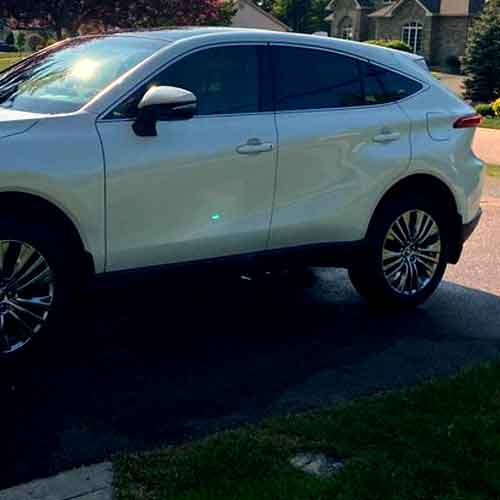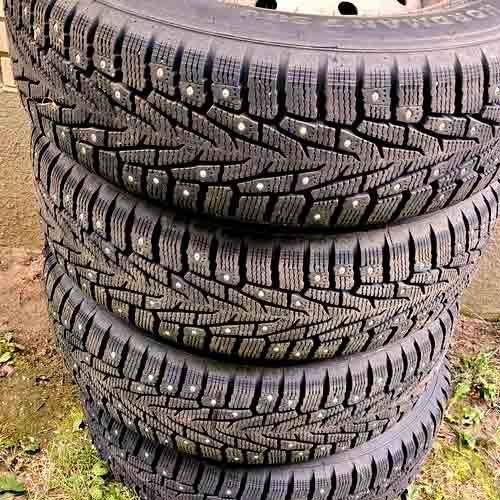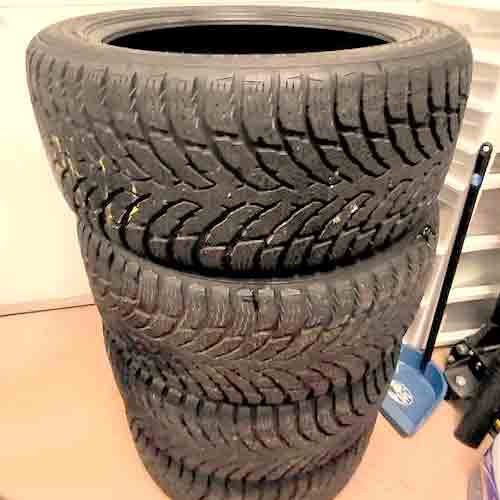Both Nokian Nordman 7 and Hankook Hakkapeliitta 9 are champions of the winter tires, each offering a unique blend of stability and traction in the harshest weather conditions. Let’s find out who reigns supreme when the temperature dips!

Table of Contents
Key Takeaway
The Hakkapeliitta 9 takes the lead when it comes to:
- Dry Traction: Offers faster braking due to its lighter structure.
- Ice Performance: Features shorter braking distances with its complex biters, slanted incisions, and extensive siping.
- Wet Traction: Superior water dispersion with its dual siping structures and multi-angled sipes.
- Comfort Levels: Exhibits reduced road noise due to a less-voided tread design and boasts quicker response times for a smoother ride.
- Fuel Economy: Offers improved fuel efficiency with its lighter structure and longitudinally aligned ribs.
- Tread Life: Benefits from a lighter structure leading to reduced friction and slower wear, coupled with a greater average tread depth.
On the other hand, the Nokian Nordman 7 (review) excels in:
- Snow Performance: Demonstrates enhanced snow traction due to aggressive directional tread pattern and better snow-to-snow contact.
- Wet Traction: Offers superior resistance to hydroplaning with its interconnected web of grooves.
- Comfort Levels: Absorbs road vibrations more effectively with its softer rubber compound, though the difference with the Hakkapeliitta 9 is minimal.
Dry Traction
When considering dry traction, the focus falls on directional grip and lateral traction.
In this regard, the Hakkapeliitta 9 outperforms, thanks to its better continuous running rib, providing constant contact with the surface.
Though that’s not the main reason here.
The main reason comes from its lighter structure, which creates less momentum inertia, so its able to slow down faster. This leads to shorter braking distances, which is of course a direct way of measuring directional grip.
On the flip side, the Nordman 7 lacks with wider grooves and greater weight, doing the opposite. These features basically cause reduced steering feedback for this tire.
Thus, the Hakkapeliitta 9 provides better handling and directional grip in dry conditions.
Snow Performance
In the face of snowy conditions, both boys exhibited an extraordinary performance, even when encountering different types of snow. However, the Nokian Nordman 7 proved itself as a robust contender in terms of traction, particularly on slightly fluffy snow terrains.

This exceptional performance is largely attributed to its meticulously engineered treads.
Offering an aggressive directional tread pattern with open-design lugs, the Nordman 7 tire gains an advantage, ensuring better snow-to-snow contact.
To explain, fluffy snow particles are effortlessly captured by the tire’s interlocking grooves and snow-vices. Once entrapped, these particles enhance the tire’s ground grip, resulting in superior traction due to the inherent adhesive nature of snow to itself rather than to rubber.
That’s why the Hakkapeliitta 9 lacks here, as it’s design is more sealed, even though both tires come with almost similarly voided up structures.
Moreover, the absence of an interlocking groove structure in Hakka doesn’t enable the tire to accumulate as much snow as its competitor, leading to slightly reduced performance in snowy conditions.
Therefore, the Nokian Nordman 7 reigns superior in snowy conditions.
Ice Performance
When encountering icy conditions, the Hakkapeliitta 9 demonstrates superior capabilities, most notably reflected in its shorter average braking distance compared to the Nordman 7.

Upon comparison, the Hakkapeliitta 9 consistently stopped a staggering 5 feet sooner.
The reason behind this superiority lies in the tire’s complex biters of various widths, slanted incisions, V-shaped notches facing both lateral directions, and plentiful siping.
These design elements significantly enhance the tire’s grip on ice and, when combined with dual-angled biters, result in a shorter braking distance.
In contrast, the Nokian Nordman 7 struggles due to its larger tread voids and fewer notches.
This tire particularly lacks in effective braking where central tread is critical.
The wider lateral tread voids and lack of multi-angled siping exacerbate the tire’s deficiencies, leading to longer handling time compared to its rival.
Wet Traction
A tire’s ability to handle wet conditions is primarily determined by its tread design and rubber compound.
While both tires feature ample siping and soft, thermally adaptive rubbers, the Hakkapeliitta 9 takes the lead in this category.
This is primarily due to the tire’s dual siping structures with more aggressive interlocking and rectilinear designs, resulting in improved biting abilities on icy surfaces.
Moreover, the multi-angled sipes of the Hakkapeliitta 9 enhance water dispersion in all directions as the tire corners, brakes, or accelerates.
Conversely, the Nokian Nordman 7’s siping, which is only laterally oriented, doesn’t deliver similar results.
However, the tire does offer better results, when it comes to resistance to hydroplaning.
In both curved and straight aquaplaning tests, the Nordman 7 managed higher speeds, attributed to its interconnected web of grooves effectively dispersing water, surpassing its counterpart’s continuous central rib.
Comfort Levels
Comfort in a tire encompasses a myriad of factors including road noise and vibration absorption, which are influenced by the tire’s tread pattern and sidewall design.
The Hakkapeliitta 9 performs slightly better in terms of tread noise due to its less-voided tread design, which restricts air flow and hence reduces noise generation.
With a lighter weight, the Hakkapeliitta 9 also comes with quicker response times, ensuring stability with that smoother ride, compared to its counterpart.
However, the Nordman 7 does enjoy an advantage with its softer rubber compound, which absorbs road bumps more effectively than the Hakkapeliitta 9.
So overall, although the Hakka is leading here, its only by a small margin.
Fuel Economy
A tire’s fuel consumption is significantly influenced by its grip on the surface and its overall weight.
The Nokian Nordman 7 falls short in both these aspects due to its considerable weight and broader tread voids, leading to increased friction as the tire rolls.
So despite enhanced performance in extreme winter temperatures, it’s evident that the tire’s shortcomings in fuel economy cannot be overlooked.
In contrast, the Hakkapeliitta 9, with its lighter structure and longitudinally aligned ribs, provides a smoother travel experience, particularly on straight-line journeys like highway drives. This design results in more efficient fuel consumption by minimizing energy expenditure.
So, the Hakkapeliitta 9 offers better fuel economy overall.
Tread Life
Tread longevity is influenced by rolling resistance.
In this aspect, the Hakkapeliitta 9 takes the lead, due to its lighter structure, which exerts less force on its tread blocks, thereby generating less friction and slower wear.
Moreover, the tire also features more tread depth on average, meaning, it takes longer to wear down to the tire-replacement tread depth.
Conversely, the Nordman 7’s greater average weight and smaller overall rubber area leads to each lug bearing more weight pressure and rubbing against the road with increased friction.
This results in quicker wear of the tire’s rubber and generates heat, the archenemy of winter tires.
It’s important to note that the performance difference between the two is marginal, perhaps explaining why neither tire offers any warranties.
Nonetheless, the Hakkapeliitta 9 tire offers a longer tread life comparatively.
Conclusion
Both tires have their distinct advantages, but the Hakkapeliitta 9 exhibits a slight edge in multiple categories. Let me explain what I mean.
So, in my evaluations between both these tires, the Hakkapeliitta 9 consistently excels in areas like dry traction due to its lightweight structure and shorter braking distances.
And here its advanced design also grants it superior grip in icy conditions, making it more efficient in wet situations.
Additionally, it offers a better fuel economy and a slightly longer tread life, largely because of its design and reduced weight.
On the other hand, the Nokian Nordman 7 distinctly shines in snow performance, especially in fluffy snow conditions, attributed to its aggressive directional tread pattern and the ability to maintain snow-to-snow contact.
While both tires present their respective strengths, the Hakkapeliitta 9 emerges with a modest advantage in several key domains.